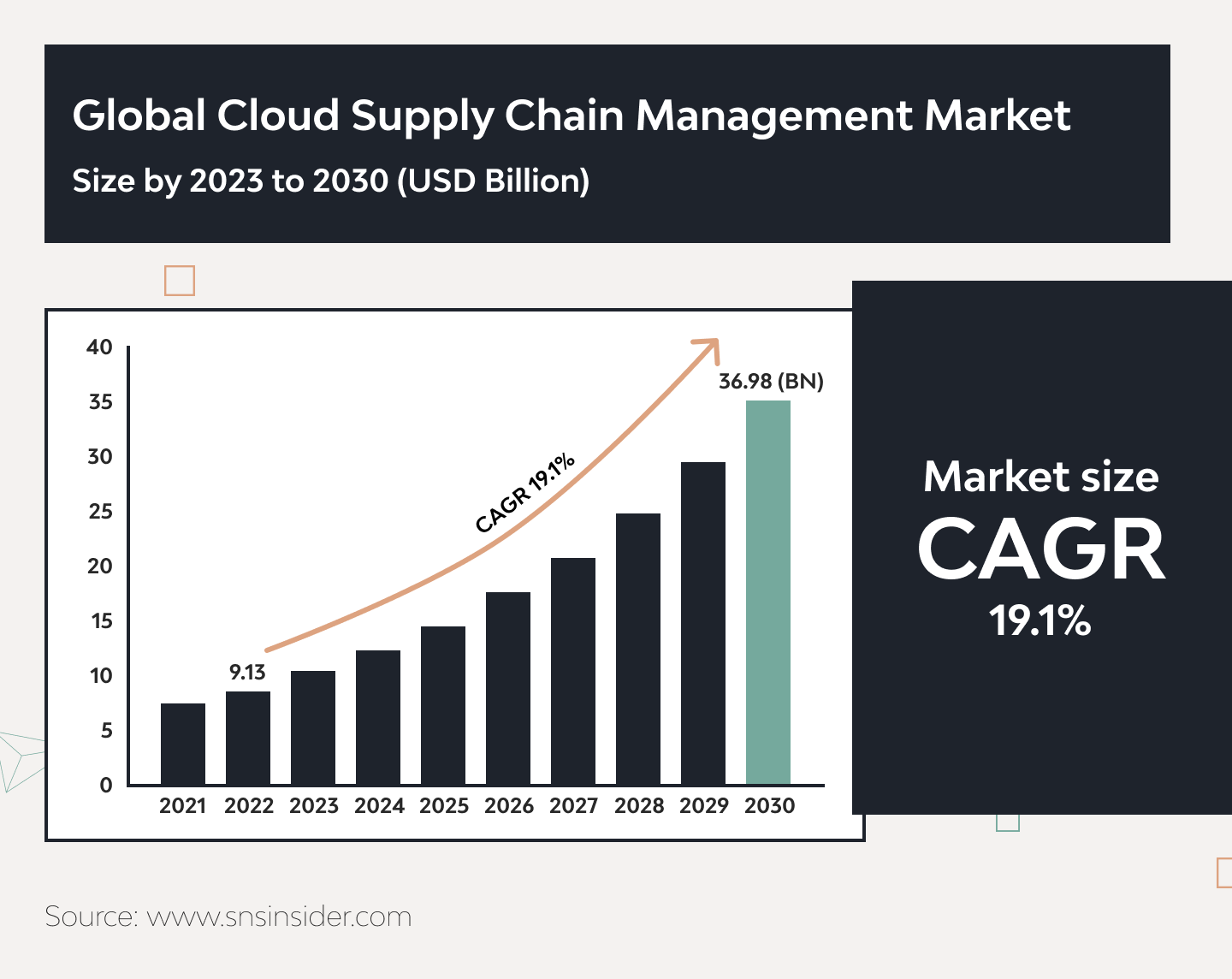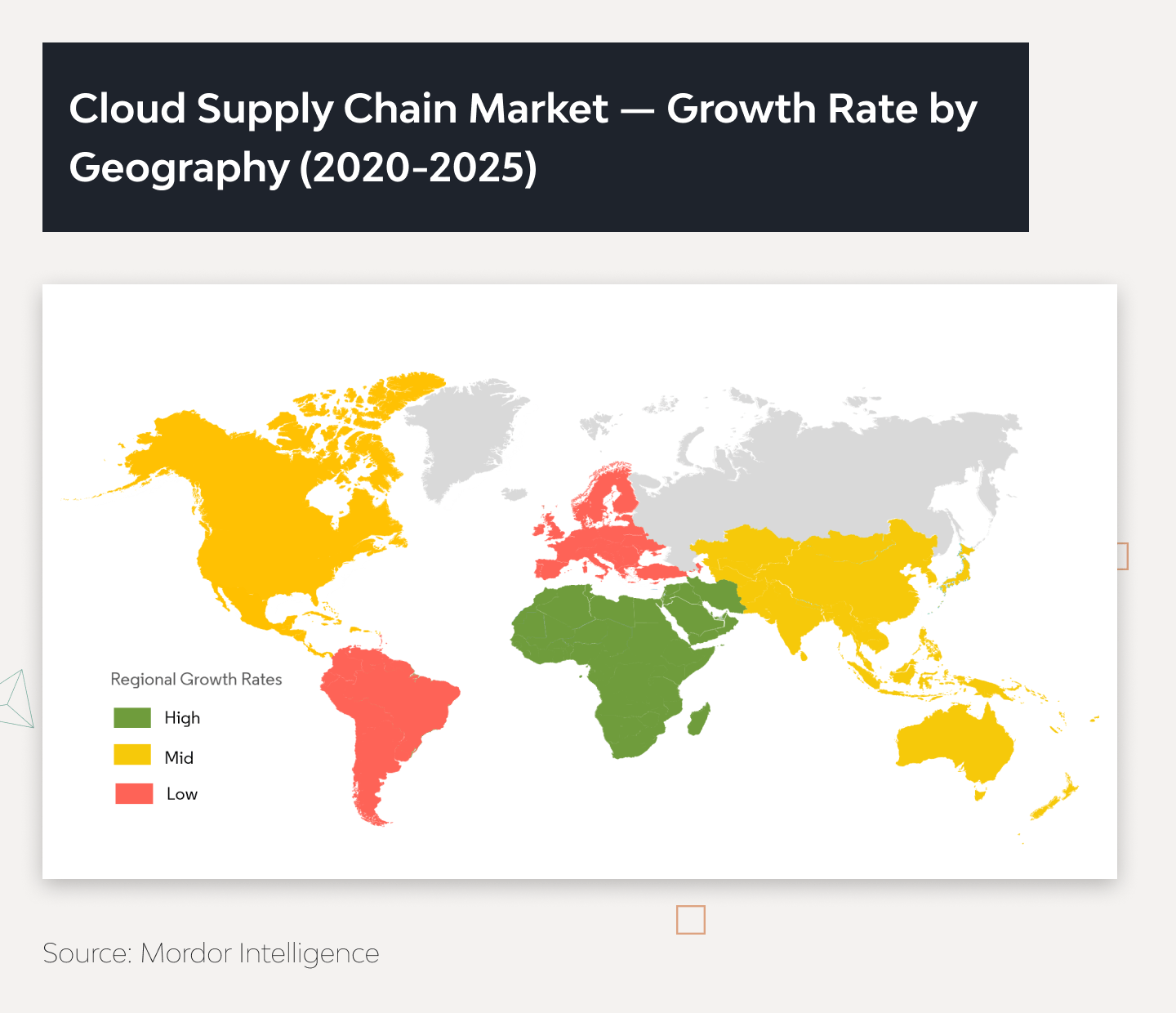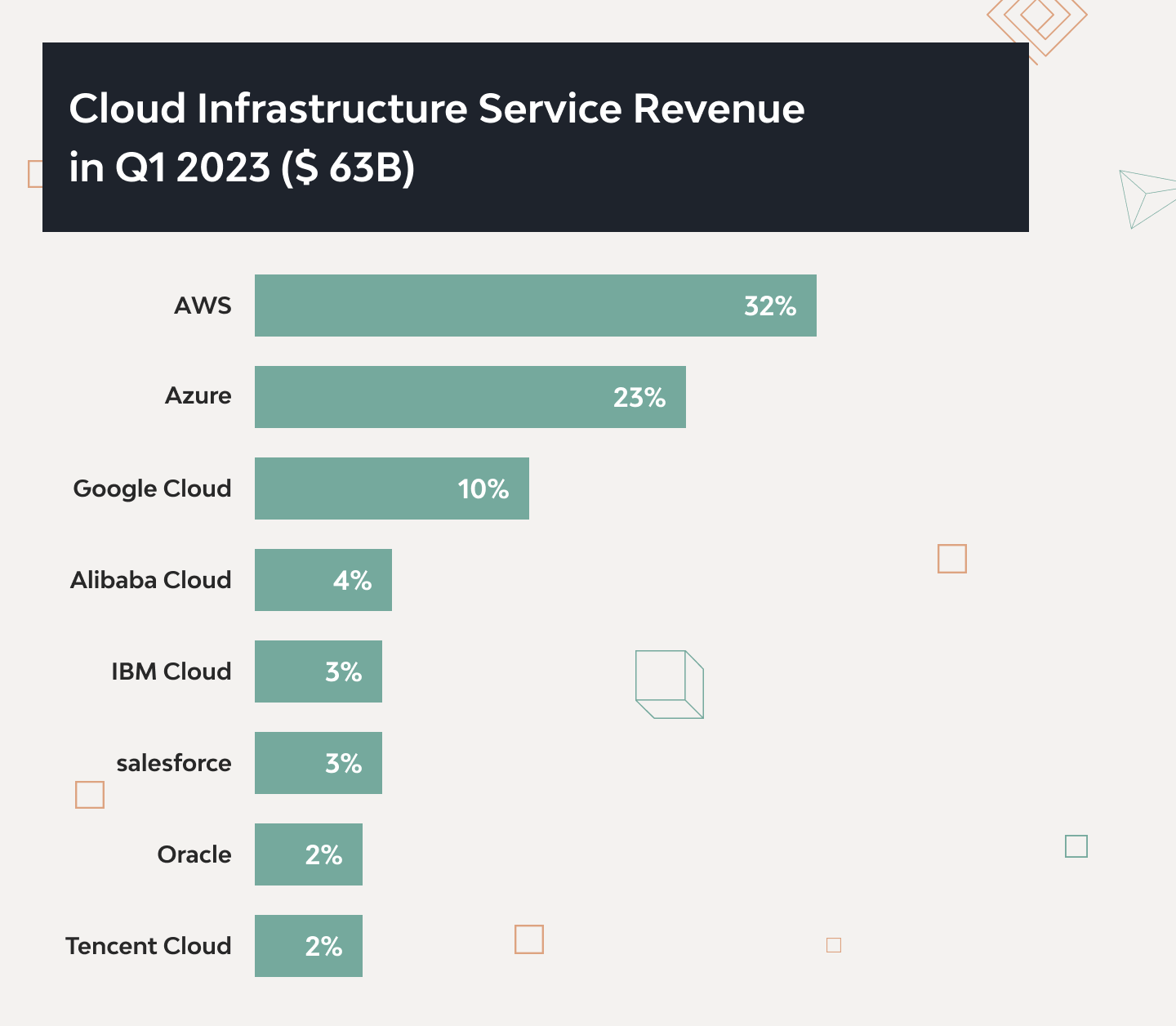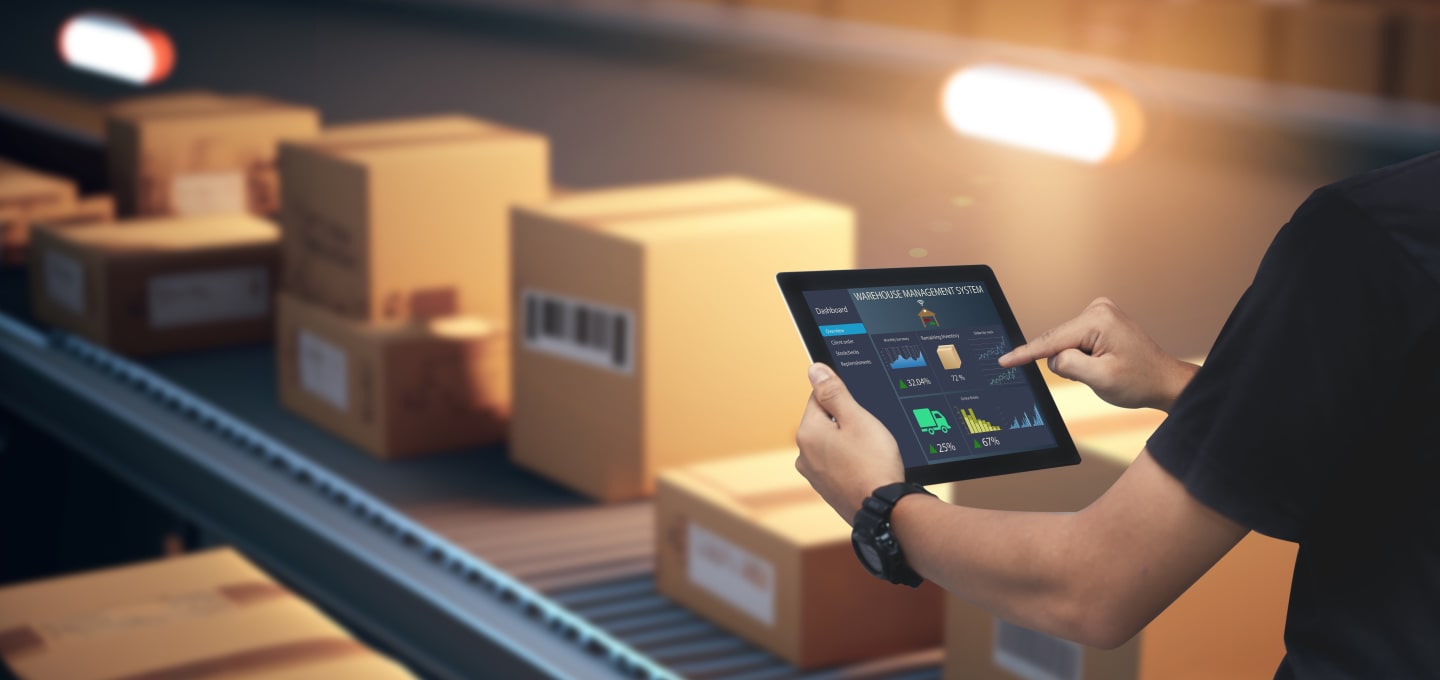How Cloud Supply Chain is Transforming Logistics

The whole digital world is buzzing around clouds in business and with good reason. Hardware and network devices become software abstractions; you don’t need to care about their maintenance. Small or huge companies may gather, operate and store their data more accessible with cloud solutions. To make it work, they don’t need old server rooms with ‘No entry’ signs and many kilometers of wires.
As a Backend Competency & Tech Lead in Django Stars, I want to talk about a business sector that benefited the most from cloud solutions adoption — logistics. Let’s uncover how the integration of the cloud in the supply chain contributes to streamlining operations and enhancing efficiency.
Traditional logistic practices are rapidly reshaping, and cloud supply chain solutions are a significant driver of this process. In 2022, the size of the cloud supply chain market was estimated at $9.13 Bn, and its projected value is expected to hit $36.98 Bn by 2030.

The level of cloud supply chain technology adoption has surged exponentially in the last few years due to rapid digitalization.
I always say that cloud technology is a complex business tool with strengths and weaknesses. It’s not a silver bullet or a magic wand. And it’s definitely not a piece of cake to implement. 62% of business owners and decision-makers admit that their companies had difficulties during cloud adoption.
Nevertheless, 60% of corporate data worldwide is stored and managed in the cloud. And this number is still growing. Gartner predicts: by 2026, over 75% of companies will adopt cloud computing services as the fundamental underlying platforms for digital transformation.

Pros and Cons of Cloud in the Supply Chain: Personal Experience
For businesses, cloud supply chain management unlocks new beneficial possibilities. Businesses no longer need to own or rent data centers and hire employees to maintain them.
But one of the most noteworthy advantages is that cloud solutions are way more affordable than actual physical servers.
For example, creating a reliable and solid data center for a US logistics company with about 1,500 employees would cost the owner approximately $300,000–500,000. The sum includes building required premisses, a hardware price, shipping, installation, and other associated costs. Furthermore, yearly expenses for maintaining servers, crew members’ salaries, and hardware updating may reach $150,000 or even more. It’s not a cheap solution, indeed.
Using cloud software for supply chain management would cost the businessman only about $3,000–5,000 monthly, and that’s all. Thus, they receive comprehensive long-term turnkey service, all included.
However, it’s not all about money. Creating a full-scale data center will take at least two months, but cloud solutions are available immediately after the payment. Sure, cloud-based supply chain management has lots of other pluses — let’s consider them in more detail.
Sure, if misused, these pros may become cons. That’s why businesses need to adopt and use clouds with a full understanding of this technology, its capabilities, and risks.

Higher scalability
Cloud solutions are utterly scalable. Using them, a client may set it up in real-time and not depend on the hardware.
Physical data centers are not flexible. They have strict capacity limits that cannot be exceeded. If the demand for an app or service has rapidly grown, it may lead to software errors, increased risks of hardware breakdowns, and poor product performance. Even top system administrators will not solve these problems fast.
Cloud in the supply chain deals with these issues in no time. A customer pays only for actually used capacities. But what is more important, there is no upper bound. During peak hours with extremely high loads, your supply chain will work steadily without delay or errors. Perhaps, it’s the only plus and cannot become a minus.
Better data safety and security
Cloud solutions use various technologies that store, classify, and protect all information to maximally reduce risks of data loss, misuse, breaches, and unauthorized access. 79% of companies using cloud-based systems admit that data security is their primary challenge.
Also, all cloud-based supply chain systems already have a built-in setup of access rights management. An administrator may easily grant the necessary access and rights to any user working with a supply chain, no more than they need. You don’t need to develop data infrastructure from scratch. But still, you need to choose a cloud solution wisely. Always check the service’s accompanying documents and certificates.
Read Also: Preventing Supply Chain Fraud
Intelligent supply chain
I can claim that implementing AI and machine learning algorithms into cloud SCM platforms helps businesses enable predictive analytics and prescriptive insights for decision-making.
Research and Market’s recent review shows that cloud-based and AI-enabled supply chains are 67% more efficient than non-AI solutions due to better risk management and lower overall costs. They might take up to 21% of the global market in the next five years.
Edge computing for IoT (Internet of Things) systems can also be deployed in the cloud. It gives managers real-time visibility into all activities in the supply chain. Tracking, identifying, and reacting to any issue would be much faster. Gartner predicts: 25% of supply chain decisions will be made across intelligent edge ecosystems through 2025.
Better uptime
Cloud data centers are divided into four tiers by uptime. The higher rank is, the better uptime a facility can guarantee. For example, a Tier III data center’s maximum downtime is only 1.6 hours per year.
Such a service can satisfy all the requirements of a business collecting and processing supply chain data 24/7 without any worries. You don’t have to hire system administrators working in shifts.
But still, possible data center updates must be considered when designing an app or a website — they must be adaptive.
Better data availability and performance
Stored data is available from anywhere in the world. It will allow different company branches to work in the same space regardless of their location. All supply chains and required data will be visible and available immediately. And this will help better track, analyze, and optimize supply routes, prices, terms, and conditions.
According to Accenture’s survey, 21% of supply chain executives have implemented cloud-based solutions across their entire processes. 97% of them have at least 3/4 of their supply chains running in the cloud. Decision-makers admitted that cloud adoption led to a 26% boost in demand forecast accuracy, reduced operating costs by 16%, and provided a 5% increase in revenue growth and profitability.
Also, I’d like to add a short review about the cons of a supply chain in the cloud. There are few, but they still need to be considered:
- Switching from one ecosystem to another is complex, the so-called ‘vendor lock-in.’ For example, migrating from Amazon to Oracle would be tricky, so it’s better to choose a suitable service wisely at the very beginning. Sure, there are ways to handle such a switch, but still.
- Cost estimation may be tricky. A client pays only for used powers, so there is no established payment. If the demand grows, the monthly payment goes up too. According to Flexera’s review, over 38% of businesses adopting cloud solutions need help with cost management.
3 Best Cloud Supply Chain Software Solutions: Brief Review for Clients
According to Statista, 65% of cloud-based services are dominated by three corporations — Amazon, Microsoft, and Google — which provide comprehensive solutions for all types of businesses, including supply chain management. The emerging integration of generative AI further advances predictive capabilities and optimizes operational efficiency.

Indeed, the most extensive systems are fine, but I recommend paying attention to specialized services that provide cloud solutions exactly for supply chain management.
Over 150 companies worldwide offer services for supply chain management in the cloud: point solutions, global processes, or full cloud integration.
According to G2’s review, there are three logistics cloud products that have the highest scores among all the others: FreightWaves Sonar (4.5 stars), Magaya Supply Chain (4.5 stars), and Cargo Wise (4.3 stars). Let’s take a glance at them:
FreightWaves Sonar
Sonar is one of the leading freight forecasting platforms worldwide, with a complete view of everything moving in the global freight economy.
Its clients get reliable real-time insights and actionable intelligence. They also can benchmark, analyze, track, and predict the global supply chain by trucking, rail, ocean, and air. Users can easily monitor all the elements impacting the freight market – trucking spot and contract rates, fuel, demand, capacity, volumes, seasonality, weather, risk management, equipment values, etc.
Magaya Supply Chain
Magaya automates repetitive manual tasks in logistics. The service can be used as separate point solutions for particular needs or as a full-fledged independent cloud-based logistics platform.
The service helps control all logistic operations components: shipping, warehousing, tracking and visibility, rates, quotes, accounting, and compliance with a single, data-driven system.
CargoWise
CargoWise is a deeply integrated logistics execution platform designed to make international trading easier.
It helps clients to execute complex transactions even in such challenging areas as cross-border compliance, freight forwarding and rating, international e-commerce, landside logistics, and warehousing. Also, it has a flexible database that simplifies operations between multiple users, countries, and currencies.
How to Implement Cloud Supply Chain: 3 Main Steps for Businesses
Step 1. Onboarding
The first step is to get all team members acquainted with the chosen cloud system. Lots of services even provide specific introductory courses for managers and operators.
Every staff member must know why the old system was out-of-date and why the company needs to change it. People are not big fans of such changes, so if they don’t get it clearly, there may be sabotage.
Employees working with databases must know all capabilities of the new cloud-based system to use the functions required to operate the company properly. On average, the onboarding stage takes 2-3 weeks.
Many former working processes will change when adopting supply chain management in the cloud. You have to make sure that all team members respond well to changes and support them. The whole future company performance depends on it.
Step 2. Technology considerations
It’s a critical decision. You must determine what exactly you need: an on-premise or a SaaS product. It will be easier if you answer the following questions:
- Do you need point solutions or a single full-fledged platform?
- Do you have the required infrastructure?
- What stack of technologies would it be built on?
- Will you outsource the development and adoption or do it in-house?
You must have a clear vision of the future cloud-based infrastructure before the adoption process starts: from tracking demand and capacities to predicting the best delivery routes and methods.
Read Also: Open-Source or SaaS in Python
Step 3. Testing
Testing is crucial in implementing cloud solutions in the supply chain management system. Before it is fully adopted, you must ensure it meets all the company’s needs ideally.
Collecting feedback from employees, managers, and stakeholders is mandatory. The crew members must complete every step they will do when working with the system. If the experience is not clear or something is uncomfortable to use, it has to be solved before full implementation. If not, it will be harder later on.
That’s why you must double-check everything, even those functions you don’t use now but may use in the foreseeable future.
Be ready that the adoption of a cloud-based solution is not the end. Developers should continue to improve the system’s stability and functionality. It’s a complex and challenging task, even for a ready-made solution.
This stage would take at least a few months. In most cases, it takes half a year or more to execute.
Cloud services have revolutionized the way how logistics industry works today. Providing scalable, agile, and high-profitable cloud solutions allows organizations to improve their supply chains and gain a competitive advantage in the global market.
Supply chains in the cloud have immense potential and are now a cornerstone of modern freight strategies. With their help, logistics companies can quickly adapt to ever-changing market demands and reach new heights in the digital world. Cloud computing is not already an innovation but a necessity for logistics companies seeking steady growth in the modern world.
- What does supply chain cloud computing look like?
- Cloud computing solutions use remote data centers and allow your logistics data to be managed more effectively. It’s possible due to storing all data in one location without dedicated servers. Moreover, many services offer solutions strictly for logistics operations that consider all variables and significantly improve supply chains.
- How is cloud computing relevant to my supply chain?
- Cloud computing simplifies all data-related calculations, works with assorted information more precisely and accurately, and allows better analysis and improvement of the supply chain in considering ever-changing conditions in the global market.
- What are the benefits of a supply chain cloud?
Here are the main benefits of cloud-based supply chain solutions:
- Reducing capital expenses and operating costs.
- Increasing efficiency and sustainability of all logistic processes.
- Unlimited scalability.
- High customizability: from point to full-fledged solutions.
- Always up to date.
- How to start a cloud-based supply chain transformation?
- Search for a cloud-based system that perfectly suits all company requirements and strategies. There are plenty of solutions designed for logistics companies; choose yours.









